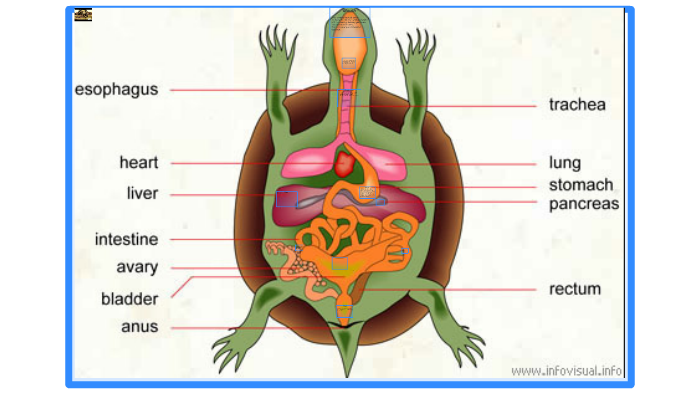Turtle Digestive System
Instead they rely on the sharp cutting edge on their jaw and use their feet to tear food while holding it in their mouth. NERVOUS SYSTEM Nervous SystemThe brain or central nervous system CNS of sea turtles is longitudinally arranged along the midline of the skull Fig.
Https Www Sps186 Org Downloads Basic 607548 Turtle
Food is mechanically and chemically broken up in the mouth of the Wood turtle.

Turtle digestive system. After being swallowed gradually enters the stomach. The windpipe which connects the larynx and bronchi of the tortoise. Turtles have a thick vascular tongue that is anchored rigidly to the floor of the mouth.
While both sea turtles and humans digestive system begins at the mouth humans have a throat which the sea turtles do not. Ethmoid epiotic prootic opisthotic basisphenoid laterosphenoid and otic Figs. Part of the digestive tract of the tortoise between the esophagus and the intestine.
Green sea turtles are the only species in which the adults are completely herbivorous vegetarian and eat primarily sea grass. It then proceeds onto the liver so it can get rid of any toxic or bacteria in the food. The morphology of the digestive tube of sea turtles is adapted to the feeding habits of the species.
The digestive system is similar to that of other vertebrates. The lining of the small intestine is textured and in many species it is honey-combed in appearance. Their anatomy is comprised of various organ systems like skeletal circulatory respiratory nervous digestive reproductive and excretory systems as described below.
Respiratory organ of the tortoise. Liver Gall Bladder and Pancreas. They break up the food into chunks by ripping it with their teeth and feet then push it down their throat with their tongue.
Then it travels through the small intestine. The stomach of the turtle has two regions. Internal anatomy of a turtle.
The brain is housed in a tubular braincase composed anteriorly of the following bones. Instead sea turtles have papillae that capture food while excess saliva runs down the esophagus. Turtles do however possess salivary glands Dawson 1998.
The cranial region and the caudal fundic pyloric region. Green juveniles are carnivorous like other species though and their digestive system actually changes as they mature to allow for this dietary shift. Identify and label figures in Turtle Diarys fun online game Digestive System Labeling.
How Spotted Turtle Digests Food 1. The largest portion is the colon and there distally a narrowing occurs forming the rectal muscle. The cecum is the most proximal region.
It serves to direct food down to its stomach. Digestive enzymes and acids within the turtles stomach decompose the food. How the Snapping Turtle digests food.
The stomach of the turtle has two regions. The digestive system is similar to That of other vertebrates. The coelom and the digestive respiratory and urogenital systems possess both primitive characteristics of their amphibian ancestors and advanced characteristics that are unique to.
An anatomy of a sea turtle The external feature of sea turtles looks simple at the first sight with their limbs head and the shell but internally it is quite complex. Powerful digestive enzymes and acids within the turtles stomach decompose the food. Comparative studies indicate that differences exist in the structure and function of digestive tubes among carnivores omnivores and herbivores and that morphological variations are governed by differences in diet Grady et al.
The esophagus is tubular digestive structure that is connected to the stomach. Reptile with an oval shell and a horned beakIt has a very short tail and four short legs and moves very slowly. Turtles are members of the Class Reptilia and represent the only living members of the Subclass Anapsida.
Turtles do however possess salivary glands Dawson 1998. The large intestine is divided into the cecum the colon and the rectum. Both species share similar stomach and small intestine functions.
The walls of the organs in the digestive system are composed of smooth muscle that helps to push the food through the system and aids in decomposition of the food by churning during the digestive process. Major internal organs of the turtle About Press Copyright Contact us Creators Advertise Developers Terms Privacy Policy Safety How YouTube works Test new features 2021 Google LLC. It is swallowed and enters the esophagus.
The walls of the organs in the digestive system are composed of smooth muscle that helps to push the food through the system. Spotted Turtles eat food drink water and breathe air with their mouth. Unlike amphibians turtles lack mucous glands.
Turtles do not have teeth. Unlike amphibians turtles lack mucous glands. Drag the given words to the correct blanks to complete the labeling.
The cranial fundic region and the caudal pyloric region.
The Digestive System The Snapping Turtle Resource
 Reptiles And Fish Veterian Key
Reptiles And Fish Veterian Key
 Turtle And Tortoise Biology Of Major Body Systems Crazy Plants Crazy Critters
Turtle And Tortoise Biology Of Major Body Systems Crazy Plants Crazy Critters
 Turtle And Tortoise Biology Of Major Body Systems Crazy Plants Crazy Critters
Turtle And Tortoise Biology Of Major Body Systems Crazy Plants Crazy Critters
 Image Result For Sea Turtle Digestive System Diagram Digestive System Diagram Turtle Animal Science
Image Result For Sea Turtle Digestive System Diagram Digestive System Diagram Turtle Animal Science
Digestive System Comparative Anatomy Project
 Turtle And Tortoise Biology Of Major Body Systems Crazy Plants Crazy Critters
Turtle And Tortoise Biology Of Major Body Systems Crazy Plants Crazy Critters
Turtles How Have These Armoured Reptiles Lived For Millions Of Years How It Works
The Digestive System Thespottedturtleresource
 Sea Turtle Digestive System Anatomy Page 1 Line 17qq Com
Sea Turtle Digestive System Anatomy Page 1 Line 17qq Com


Comments
Post a Comment